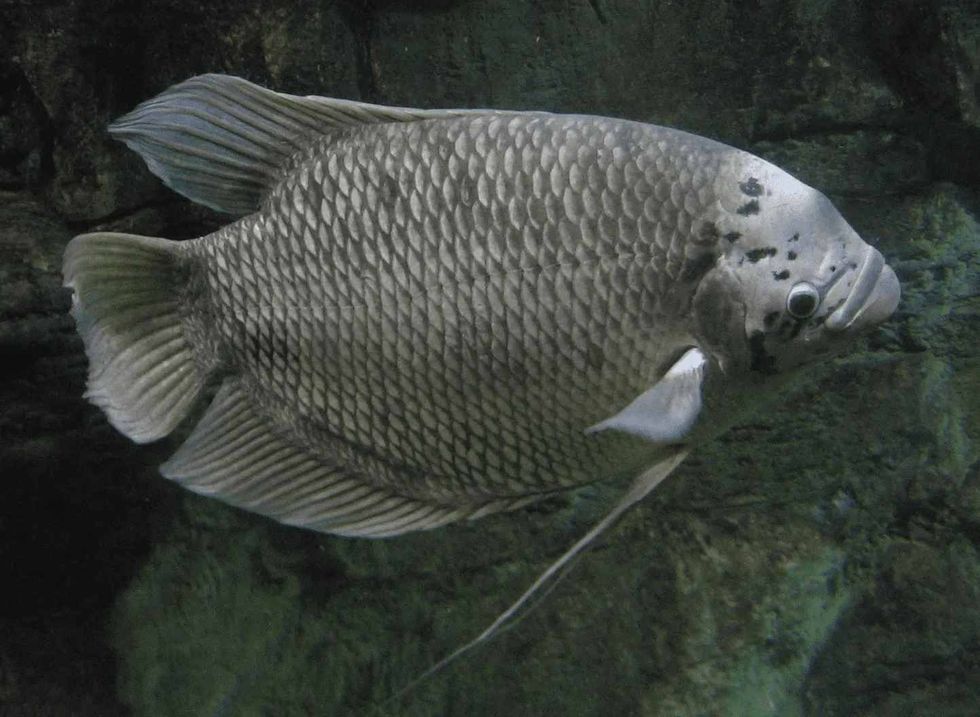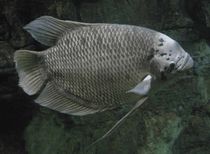Are you interested to know about one of the most common aquarium fishes? The giant gourami (Osphronemus goramy) is native to different areas of southeast Asia, but they have made it to human homes as a pet.
The giant gourami has a flattened look, similar to other gourami fishes, except for its large size. Like other gouramis, this fish also has a labyrinth organ that allows it to directly take oxygen from the air by swimming above the water's surface.
The tank of giant gourami needs to be pretty large to accommodate its size. It has also been treated as a food fish in Southeast Asia.
Even though both fish belong to the same gourami group, the red-tail giant gourami has been classified under a different taxonomic name. It is easy to care for the giant gourami, and the fish is even happy to eat plant-based foods.
Want to know more interesting giant gourami facts? Keep reading! Also, check out our articles on the Pacific Cod and the Giant trevally.
Giant Gourami Interesting Facts
What type of animal is a Giant Gourami?
The giant gourami (Osphronemus goramy) is a type of large fish originally living in freshwater environments.
What class of animal does a Giant Gourami belong to?
The giant gourami (Osphronemus goramy) belongs to the class Actinopterygii and the family Osphronemidae.
How many Giant Gouramis are there in the world?
The exact number of giant gouramis cannot be determined as this freshwater fish is heavily bred to be kept in aquariums.
Where does a Giant Gourami live?
The giant gourami (Osphronemus goramy) is extant in Southeast Asia, in countries like Cambodia, Vietnam, Thailand, Malaysia, and Indonesia. The giant gourami found in the Mekong basin is especially popular among fish enthusiasts. However, they have been extensively bred as pet fish making them popular in several places all over the world.
What is a Giant Gourami's habitat?
The giant gourami is a freshwater fish species, and in its natural habitat, the fish is found in large rivers, swamps, ponds, and lakes, as well as in water bodies with a slow water flow. This fish thrives in clean water conditions. It lives in medium-deep water and prefers a habitat that is rich with aquatic plants.
Who do Giant Gouramis live with?
Gouramis are known for being on their own, and the fishes typically come together only to breed. However, in an aquarium, the giant gourami fish can be kept with other fishes that are bigger than it. Two male giant gouramis can't be kept together because of their aggressive nature.
How long does a Giant Gourami live?
The average lifespan of giant gourami (Osphronemus goramy) is around 20 years. The gourami giant has been known to live for a long time in good aquarium conditions. Pink-colored gouramis may live for fewer years.
How do they reproduce?
The male giant gourami (Osphronemus goramy) starts to make a bubble nest during April and May. The bubble nest helps in protecting the thousands of eggs laid by the female giant gourami.
Fertilization of eggs happens outside the body. The eggs hatch in 24-48 hours and the fry comes out as free-swimming fish. As the nest has been built by the male.
It takes care of the nest and does so in a jealous way. The father giant gourami fish may behave aggressively if someone tries to go near his nest.
What is their conservation status?
According to the International Union for Conservation of Nature (IUCN), the giant gourami (Osphronemus goramy) has the status of Least Concern.
Giant Gourami Fun Facts
What do Giant Gouramis look like?

The giant gourami looks like other gouramis, and it has a similarly flattened body. They are usually pale to golden yellow at first, but it grows dark blue or black as it turns into an adult.
The adult male also grows a hump on the top of its head while going through the change, and it helps you to differentiate it from the female. The pink gourami is probably created by extensive breeding of the species.
Other colored gouramis that you might see are artificially colored, and they may not stay alive for a long time. This fish also has large anal fins and the females tend to have thicker lips.
How cute are they?
Well, the Osphronemus goramy fish are certainly cute because of their flat body and beautiful color. However, some people have described them as ugly because of the odd look it gets as it grows up.
How do they communicate?
Gouramis are known for having great hearing because of a special organ present inside their ear canal. The hearing helps gourami to easily get around in the wild. This fish can also be territorial, especially towards giant gouramis of the same sex, and it often aggressively pushes the other fish.
How big is a Giant Gourami?
The adult size of giant gourami can vary between 16-28 in (40-70 cm). However, 18 in is the average size for both wild and aquarium giant gourami fish. This fish is about two times bigger than the kissing gourami which reaches an average length of 12-15.5 in (30-40 cm).
How fast can a Giant Gourami swim?
Not much is known about the exact swimming speed of the giant gourami, but it is quite a slow fish.
How much does a Giant Gourami weigh?
The giant gourami can weigh 20 lb (9 kg) or even more depending on its size.
What are the male and female names of the species?
There are no special names for the male and female of this large fish species.
What would you call a baby Giant Gourami?
The baby giant gourami is called a fry.
What do they eat?
The giant gourami (Osphronemus goramy) leans towards using plants and algae as its main source of sustenance. However, in an aquarium, it can easily adapt to a diet of fish food flakes or live food like bloodworms and brine shrimp. In the wild, the diet may also include aquatic insects. Some people have also included blanched vegetables.
Are they dangerous?
The giant gourami isn't dangerous for humans, but it can be a tad dangerous for fish that are smaller than it in size. It is often known for picking a fight, and this fish may end up chewing through the fins of the other fishes.
Would they make a good pet?
Yes, the giant gourami makes a good aquarium or tank fish. Giant gourami care is fairly simple, so even a kid can take care of the fish. However, it should be noted that this is a fast-growing fish, so it will need a large fish tank to thrive.
Did you know...
In some parts of Southeast Asia, the giant gourami is preserved with salt and eaten as a delicacy.
A pet giant gourami may face some health issues like bacterial infections on its skin and constipation.
The Giant Gourami's tentacles
The giant gourami fish species has tentacles that are modified fins. It is theorized that in the wild the tentacles are used by the fish to look for food or to get a feel of its environment.
Keeping Giant Gouramis
The giant gourami is easily found with popular fish breeders. Giant gourami care is fairly simple.
An adult giant gourami requires a fish tank size of 200 gallons to swim efficiently. An ideal water temperature of 68-86°F should be maintained in the aquarium to keep the fish happy and healthy. It should never be put into a brackish water fish tank.
As the giant gourami fish can grow quite big, it needs to have a big tank if you are going to keep it as a pet. You need to feed the fish once or twice a day, the fish isn't fussy about food, and it won't need a lot of food in its diet.
If you want to include tank mates, think about adding hardy fishes like large catfishes.
Interested in breeding the fish? Try a large tank with clear water optimal temperature conditions and a proper filter.
Here at Kidadl, we have carefully created lots of interesting family-friendly animal facts for everyone to discover! Learn more about some other fish including the king salmon and the codfish.
You can even occupy yourself at home by drawing one on our Giant Gourami coloring pages.










